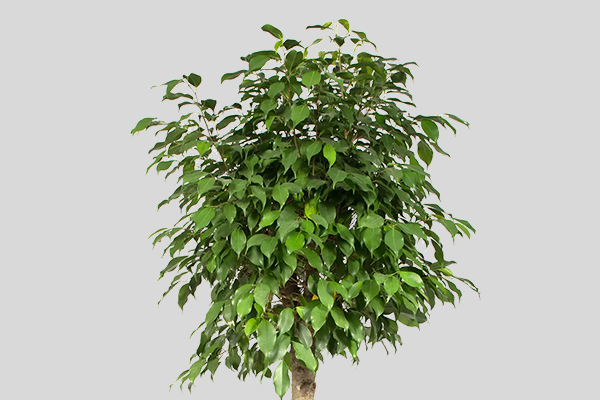
Ficus Benjamina
Ficus Benjamina is one of the most popular indoor ficus varieties. It is valued for its graceful leaves and ornamental crown, which can be shaped as desired. The plant is relatively undemanding but requires proper care to remain healthy and attractive for many years.
Placement
Ficus Benjamina prefers bright rooms with plenty of diffused light. The ideal location is near east- or west-facing windows. On the south side, light shading is necessary to protect the leaves from burns. In low light conditions, the leaves may turn yellow and fall, so additional lighting is recommended on the north side. The plant does not tolerate drafts or frequent relocation — moving or turning the pot can cause stress and leaf drop.
Watering
Watering should be moderate. The top layer of soil should dry 2–3 cm deep before the next watering. In summer, watering twice a week is sufficient; in winter, once every 7–10 days. Excess moisture can cause root rot, while prolonged dryness may lead to leaf drop. Use soft, settled, room-temperature water. Ficus Benjamina enjoys high humidity, so occasional spraying and a humidifier are beneficial.
Feeding
Fertilization is required during the active growing season, from April to September. Use complex fertilizers for ornamental foliage plants, ideally once every two weeks. In autumn and winter, when the plant rests, fertilization is rare or stopped entirely. Regular feeding promotes new shoots and keeps the foliage vibrant.
Repotting
Young ficus plants should be repotted annually in spring, using a pot slightly larger than the previous one. Mature specimens can be repotted every 2–3 years. Proper drainage is essential to avoid water stagnation. If the roots completely surround the soil clump, a full repotting is needed; otherwise, replacing the top layer of soil is sufficient. The soil mix should be fertile, loose, and well-draining: turf soil, leaf compost, and sand in equal parts.
Temperature
The optimal temperature for Ficus Benjamina is between +18 and +25 °C. In winter, temperatures should not drop below +15 °C. The plant is not frost-resistant, and even brief frosts can be harmful. It is also important to avoid sudden temperature fluctuations and cold air drafts from windows or air conditioners.
Pruning
Ficus Benjamina tolerates pruning well and requires it to maintain a neat shape. Pruning is best done in spring or early summer. Overly long shoots should be shortened to give the crown the desired appearance. Old, dry, or damaged leaves should be removed regularly. With proper pruning, the plant can be shaped into either a compact bush or a small standard tree.
Conclusion
Ficus Benjamina is a versatile indoor plant suitable for both homes and offices. It requires bright diffused light, moderate watering, regular feeding, and occasional repotting. With proper care, it remains decorative and healthy for many years.
